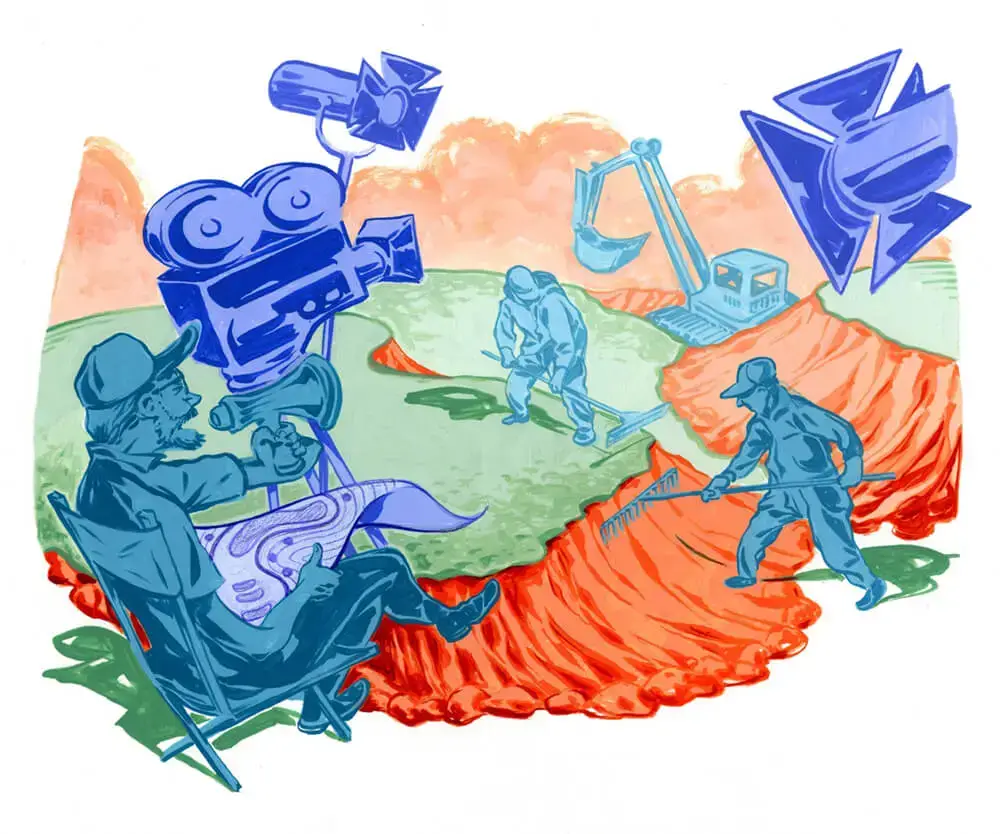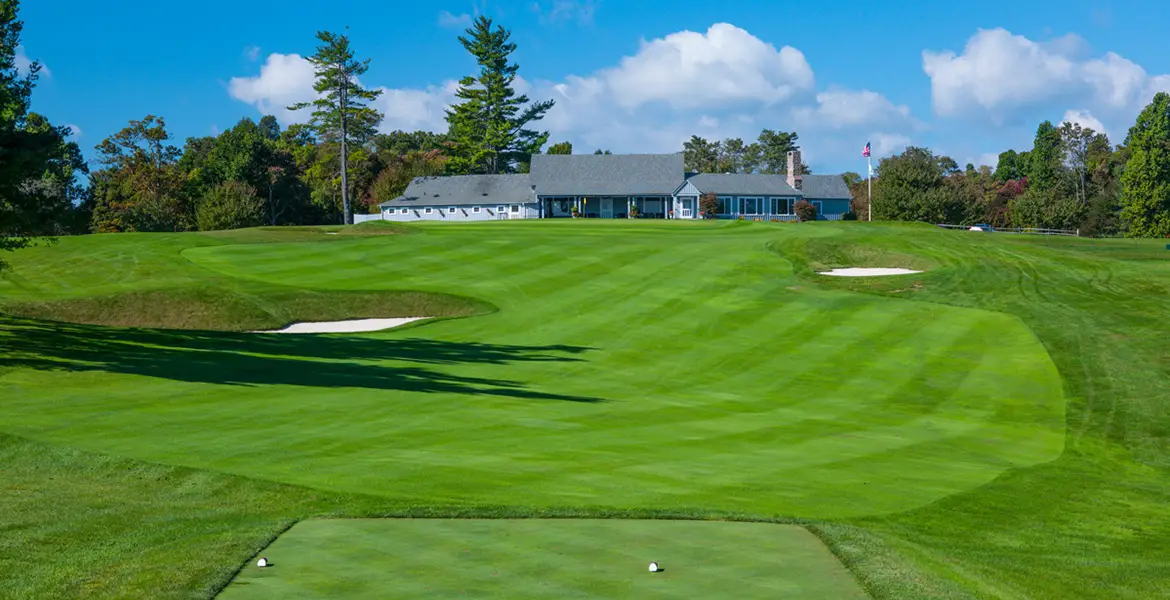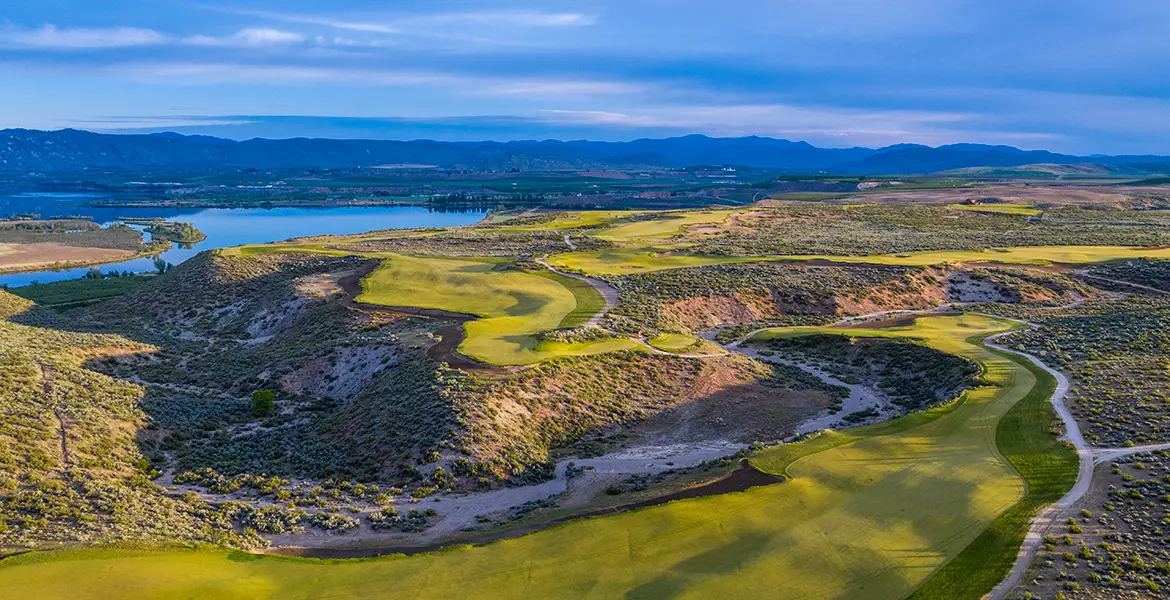Visionaries, craftsmen, and taskmasters, golf course architects and movie directors share many of the same talents—and temperaments
Amateur golf architect George Thomas never emerged from a barranca yelling “Cut!” And he never audaciously insisted on cutting up a marble floor to get his strategic angles just right, a bit of legendary assiduousness attributed to a determined Orson Welles while making Citizen Kane. But the architects of June’s U.S. Open venue set in the heart of Tinseltown—Los Angeles Country Club’s North Course—share plenty in common with the auteurs working for studios mere blocks from where the USGA’s annual summer blockbuster will be played.
For starters, film and golf course design share similar storytelling arcs. Each involves an uncanny ability to craft something from paper into a grand stage for performers. Both fields balance form, function, and managing harebrained ideas cooked up by financiers who mean well. Sometimes. And the finished product in both crafts reflects the idiosyncrasies of their figureheads, whether they’re directors or course designers. The moviemaking process starts with a premise turned into a script. In golf design, it’s either a dream, business plan, or complicated combination of each that morphs into a paper rendering. Course developers and Hollywood producers who shepherd these projects must have a grasp of history, business, art, science, and an encyclopedic knowledge of previous successes or failures. The purse-string-pullers also have to be daring enough to entrust millions to zany creative types better known as directors and golf architects, each of whom has a unique way of working.

The bigger egos dramatically scream “ACTION!” while demanding that actors adhere to the script and vision. We see photos of them enjoining fingers to form an air lens, which, if all goes well, gets shown when they’re up for an Oscar. Other directors eschew the ego displays and formalities by gently encouraging a good ad-lib from actors if the lines somehow improve the picture. And while most filmmakers insist on multiple angles and takes to get the scene just right, relaxed types like Clint Eastwood will shock actors by embracing the first take.
The best golf architects are just as wide-ranging in their processes and egomaniacal tendencies. Some start with detailed plans and never enjoy life more than pointing to piles of dirt as cameras click, a blueprint prop nearby, and fawning entourage hanging on every word. Others keep a lower profile and are more amenable to adjustments as a project goes, delighting in the golf equivalent of an ad-lib by embracing strange little occurrences during construction. And the surrounding “teams” say a lot about the temperament and amenability of directors and designers.
Steven Spielberg has worked with different plots, genres, studio chiefs, and actors. But when it comes time to film, he nearly always reconvenes the same crew. There’s the legendary John Williams creating unforgettable scores. Brilliant cinematographer Janusz Kaminski injecting each film with a look to reflect the time, place, and mood. And 92-year-old editor Michael Kahn, who knows exactly what the boss wants after four decades together. Spielberg keeps the train rolling year after year without a sameness despite relying on the same people.
In course design, those top craftspeople are the field supervisors and shapers. Donald Ross might be golf architecture’s answer to Spielberg in output, temperament, consistency, love of craft, and even a nuanced ability to reinvent over a long career. Ross relied on a similar team of devoted craftspeople who carried out his detailed drawings, with each project varying just enough to leave a vast and timeless portfolio behind.
On the eccentric side, A.W. Tillinghast almost certainly was golf’s Orson Welles. Though both eccentrics stuck to core storytelling fundamentals, their imaginations and boundary-pushing ways could not be restrained. Each could be irascible and difficult. Both loved Broadway and dabbled in theater, Wells with far more success prior to moving west. Each artiste emerged after death as a “forgotten genius,” the title given to Tillinghast by former USGA Executive Director Frank Hannigan in a 1974 Golf Journal biographical deep-dive. Each legend died in relative obscurity and on shaky financial footing after investing in his projects. Welles hawked wine in the 1970s and Tillinghast sold antiques in Beverly Hills. Today, they’re seen as giants.
If C.B. Macdonald was the confident visionary who stood his ground to show better ways of doing things—no more chocolate-drop mounds!—then Francis Ford Coppola might be his Hollywood equivalent. Both battled with their share of opposing forces. Macdonald pushed back at clueless bluebloods who, unlike him, never studied under Old Tom Morris or played the great links. Coppola fought with studio executives who trusted his boldness up to a point when making The Godfather. Both ushered in eras of grand blockbusters inspired by the classics.
And the Alfred Hitchcock of golf architecture? Why, of course, it’s George Thomas, the visionary behind L.A. North.
Working with severe canyon sites prone to drainage issues—i.e., complicated scripts with layered plots—Thomas knew his first pass at L.A. North in 1921 could be better. He had an excuse since he was serving as the editor of Herbert Fowler’s plan more than carrying out his vision. But by 1927, when he got the go-ahead to totally revamp the layout, Thomas had a roster of masterworks crafted by a well-oiled team. His artistic renaissance came when he began collaborating with a clever local superintendent and engineering whiz named Billy Bell.
Hitchcock’s greatest films came after joining forces in 1951 with innovative cinematographer Robert Burks. Like that creative duo, Thomas and Bell unleashed bold and wildly varied epics at Ojai Valley Inn, La Cumbre, Bel-Air, Riviera, and L.A. North, rivaling Hitchcock and Burns’s run of Rear Window, To Catch a Thief, Vertigo, and North by Northwest. Thomas even made the golf architectural equivalent of Hitchcock cameos in his work: He started every course with an easy par five and tough par four to let you know this was his vision (and to get play moving).
Hitchcock’s burst of epic creativity happened in the 1950s, well after Thomas died in 1932 just a few years after completing his redesign of 2023’s U.S. Open theater. But the two men were inextricably linked another way: Hitchcock lived in a home along Thomas’s 15th hole at Bel-Air for nearly 40 years. Hooray for Hollywood!
Thank you for supporting our journalism. If you prefer to read in print, you can also find this article in the Summer 2023 issue of LINKS Magazine. Click here for more information.






